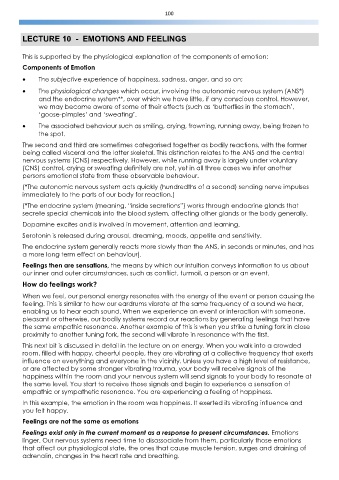Page 100 - C:\Users\STEVEB~1\AppData\Local\Temp\msoF8C5.tmp
P. 100
ϭϬϬ
/(&785( - (027,216 $1' )((/,1*6
This is supported by the physiological explanation of the components of emotion:
Components of Emotion
· The subjective experience of happiness, sadness, anger, and so on;
· The physiological changes which occur, involving the autonomic nervous system (ANS*)
and the endocrine system**, over which we have little, if any conscious control. However,
we may become aware of some of their effects (such as ‘butterflies in the stomach’,
‘goose-pimples’ and ‘sweating’.
· The associated behaviour such as smiling, crying, frowning, running away, being frozen to
the spot.
The second and third are sometimes categorised together as bodily reactions, with the former
being called visceral and the latter skeletal. This distinction relates to the ANS and the central
nervous systems (CNS) respectively. However, while running away is largely under voluntary
(CNS) control, crying or sweating definitely are not, yet in all three cases we infer another
persons emotional state from these observable behaviour.
(*The autonomic nervous system acts quickly (hundredths of a second) sending nerve impulses
immediately to the parts of our body for reaction.)
(*The endocrine system (meaning, “inside secretions”) works through endocrine glands that
secrete special chemicals into the blood system, affecting other glands or the body generally.
Dopamine excites and is involved in movement, attention and learning.
Serotonin is released during arousal, dreaming, moods, appetite and sensitivity.
The endocrine system generally reacts more slowly than the ANS, in seconds or minutes, and has
a more long term effect on behaviour).
Feelings then are sensations, the means by which our intuition conveys information to us about
our inner and outer circumstances, such as conflict, turmoil, a person or an event.
How do feelings work?
When we feel, our personal energy resonates with the energy of the event or person causing the
feeling. This is similar to how our eardrums vibrate at the same frequency of a sound we hear,
enabling us to hear each sound. When we experience an event or interaction with someone,
pleasant or otherwise, our bodily systems record our reactions by generating feelings that have
the same empathic resonance. Another example of this is when you strike a tuning fork in close
proximity to another tuning fork, the second will vibrate in resonance with the first.
This next bit is discussed in detail in the lecture on on energy. When you walk into a crowded
room, filled with happy, cheerful people, they are vibrating at a collective frequency that exerts
influence on everything and everyone in the vicinity. Unless you have a high level of resistance,
or are affected by some stronger vibrating trauma, your body will receive signals of the
happiness within the room and your nervous system will send signals to your body to resonate at
the same level. You start to receive those signals and begin to experience a sensation of
empathic or sympathetic resonance. You are experiencing a feeling of happiness.
In this example, the emotion in the room was happiness. It exerted its vibrating influence and
you felt happy.
Feelings are not the same as emotions
Feelings exist only in the current moment as a response to present circumstances. Emotions
linger. Our nervous systems need time to disassociate from them, particularly those emotions
that affect our physiological state, the ones that cause muscle tension, surges and draining of
adrenalin, changes in the heart rate and breathing.

